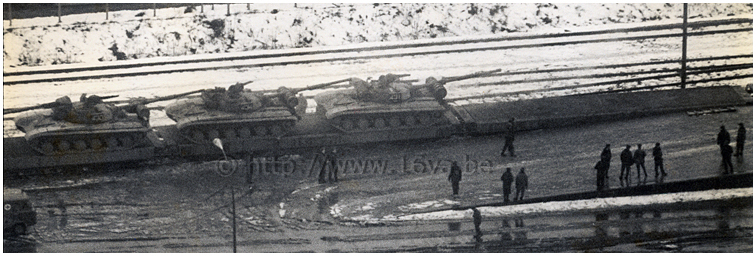
 Roland Pietrini was a member of the French Military Liaison Mission (FMLM) to the Soviet High Command in Germany between 1979 and 1983.
He was then posted to Warsaw where he continued his intelligence missions from 1986 until 1989. He explains for us the nature of the observation
flights carried out by the FMLM above the Berlin Control Zone.
Roland Pietrini was a member of the French Military Liaison Mission (FMLM) to the Soviet High Command in Germany between 1979 and 1983.
He was then posted to Warsaw where he continued his intelligence missions from 1986 until 1989. He explains for us the nature of the observation
flights carried out by the FMLM above the Berlin Control Zone.
Aboard the Broussard
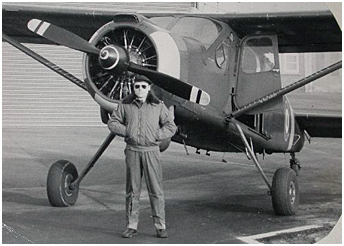 Roland Pietrini devant un Broussard de l'Armée de l'air à Tegel. © R.Pietrini.
Roland Pietrini devant un Broussard de l'Armée de l'air à Tegel. © R.Pietrini.
Roland Pietrini in front of a French AF Broussard at Tegel. © R.Pietrini.
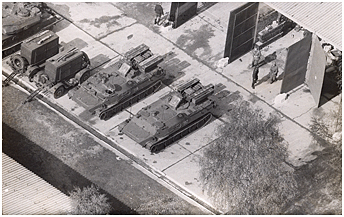 « The Broussard is galloping through the sky above the GDR. Once above the target, Lieutenant Colonel Augoyard, one of the pilot officers
assigned to the FMLM, positions his aircraft with the sun at his back, banking gently to the right so that the equipment to photograph
'enters' the viewfinder of his observer, Major Pietrini. During a previous flight, it had been noticed that some panels of a particular
hangar roof were missing and that it consequently was possible to photograph the SA-13 parked inside. Fortunately, an armored anti-aircraft
vehicle is outside the hangar today and the observer uses his 400mm lens to photograph the area located between the missiles and the protective
glass of the mirror that hides the IR guidance system. A Soviet soldier on a MT-LB (1)
nearby watches in disbelief as the aircraft flies over;
an alert certainly will be sounded, but it will be too late. The crew has no worries, they are just focused on their job. But here are the
Schönwalde and Wüstermark train stations. The NCO observer is looking for an observation post for tonight when he will be on the ground on
the "Local" (2).
A convoy with command trucks is leaving the Dallgow area and traffic regulators or "reggies" are in position at the
intersection of Route 5 and Route 273. This night promises to be exciting. At the Priort train station, so difficult to access by track
when tank boarding is imminent, the observer spots heavy flatbeds and M-wagons (3).
The latter and also ZIL-131 workshop trucks near the
platforms are clear signs of a forthcoming loading operation. Moreover, identical observations are made at the Satzkorn and Dallgow train stations. »
« The Broussard is galloping through the sky above the GDR. Once above the target, Lieutenant Colonel Augoyard, one of the pilot officers
assigned to the FMLM, positions his aircraft with the sun at his back, banking gently to the right so that the equipment to photograph
'enters' the viewfinder of his observer, Major Pietrini. During a previous flight, it had been noticed that some panels of a particular
hangar roof were missing and that it consequently was possible to photograph the SA-13 parked inside. Fortunately, an armored anti-aircraft
vehicle is outside the hangar today and the observer uses his 400mm lens to photograph the area located between the missiles and the protective
glass of the mirror that hides the IR guidance system. A Soviet soldier on a MT-LB (1)
nearby watches in disbelief as the aircraft flies over;
an alert certainly will be sounded, but it will be too late. The crew has no worries, they are just focused on their job. But here are the
Schönwalde and Wüstermark train stations. The NCO observer is looking for an observation post for tonight when he will be on the ground on
the "Local" (2).
A convoy with command trucks is leaving the Dallgow area and traffic regulators or "reggies" are in position at the
intersection of Route 5 and Route 273. This night promises to be exciting. At the Priort train station, so difficult to access by track
when tank boarding is imminent, the observer spots heavy flatbeds and M-wagons (3).
The latter and also ZIL-131 workshop trucks near the
platforms are clear signs of a forthcoming loading operation. Moreover, identical observations are made at the Satzkorn and Dallgow train stations. »
This paragraph is an excerpt from the book "Propusk" by Patrick Manificat, published by Lavauzelle Editions.
See > Multimedia
Seen from the sky
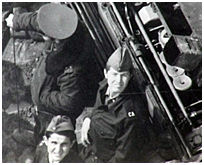
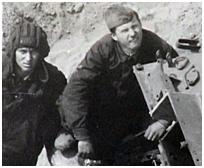 Aerial reconnaissance conducted in turn by the three Allied Military Liaison Missions (4)
in the Berlin Control Zone (BCZ) became a daily task in 1964. This particular bubble with a diameter of 64 km and height of 3000 meters corresponded
to the approach area of civilian air traffic over West Berlin. The BCZ was connected to the FRG by three corridors: center, north and south. One must
imagine three cylinders in which air traffic was restricted and monitored by the Soviets. It was a true umbilical cord linking the West to West Berlin,
a Western island isolated in the Eastern world. Today, the strict constraints the Soviets imposed after the fall of the Third Reich in 1945 until the
fall of the Berlin Wall in 1989 are difficult to comprehend for those who have not lived them. The consistency with which the historic American,
British and French allies maintained a presence and surveilled without fail the largest concentration of military means positioned against the West
needs to be underscored.
Aerial reconnaissance conducted in turn by the three Allied Military Liaison Missions (4)
in the Berlin Control Zone (BCZ) became a daily task in 1964. This particular bubble with a diameter of 64 km and height of 3000 meters corresponded
to the approach area of civilian air traffic over West Berlin. The BCZ was connected to the FRG by three corridors: center, north and south. One must
imagine three cylinders in which air traffic was restricted and monitored by the Soviets. It was a true umbilical cord linking the West to West Berlin,
a Western island isolated in the Eastern world. Today, the strict constraints the Soviets imposed after the fall of the Third Reich in 1945 until the
fall of the Berlin Wall in 1989 are difficult to comprehend for those who have not lived them. The consistency with which the historic American,
British and French allies maintained a presence and surveilled without fail the largest concentration of military means positioned against the West
needs to be underscored.
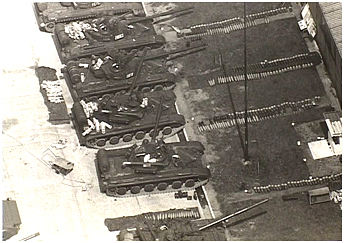
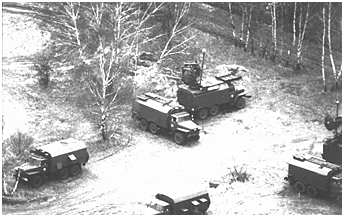 The Allied Military Liaison Missions contributed to intelligence gathering in this zone thanks to observation flights above the BCZ and,
to a lesser extent, inside some of the Berlin air corridors. It must be remembered that the concentration and the density of military targets
as well as assets of military interest within the BCZ were impressive. The Group of Soviet Forces in Germany (GSFG) deployed three divisions
(two armored and one mechanized), an artillery brigade and two brigades of
FROG and Scarab
ground-to-ground missiles with nuclear capability
within a radius of 60 km around West Berlin. The BCZ also included two major airbases, Oranienburg (with heavy transport, attack and SIGINT helicopters)
and Werneuchen (with some of the most threatening aircraft of the time such as ground-attack, reconnaissance and electronic warfare Yak-27 and -28, plus
the formidable reconnaissance/bombardment and electronic warfare MiG-25 "Foxbat"). Also, the East-German National People's Army (NVA) fielded a motorized
rifle division and a border guards division equipped with their own armored vehicles.
The Allied Military Liaison Missions contributed to intelligence gathering in this zone thanks to observation flights above the BCZ and,
to a lesser extent, inside some of the Berlin air corridors. It must be remembered that the concentration and the density of military targets
as well as assets of military interest within the BCZ were impressive. The Group of Soviet Forces in Germany (GSFG) deployed three divisions
(two armored and one mechanized), an artillery brigade and two brigades of
FROG and Scarab
ground-to-ground missiles with nuclear capability
within a radius of 60 km around West Berlin. The BCZ also included two major airbases, Oranienburg (with heavy transport, attack and SIGINT helicopters)
and Werneuchen (with some of the most threatening aircraft of the time such as ground-attack, reconnaissance and electronic warfare Yak-27 and -28, plus
the formidable reconnaissance/bombardment and electronic warfare MiG-25 "Foxbat"). Also, the East-German National People's Army (NVA) fielded a motorized
rifle division and a border guards division equipped with their own armored vehicles.
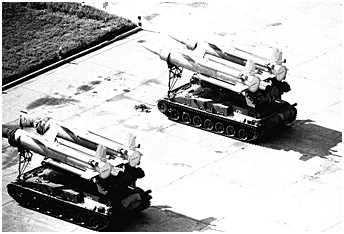
 No less than 135,000 men, 1550 tanks, 2500 armored vehicles, 1250 artillery pieces, about 40 combat aircraft and 40 helicopters spread over 300 sites,
barracks and different storage facilities were concentrated in the BCZ! In Berlin, the Soviet brigade from Karlshorst gathered no less than 200 tanks
specifically to ensure the security of East Berlin. The need to build a third airport in West Berlin arose in 1948. The space left vacant by a training
range near the Hermann Goering camp (it became the "Napoleon Quarter" when the French troops took up residence there in 1945) was considered as the only
place suitable for the new airport. Thanks to a requisitioned workforce of 15,000 Berliners, including 11,000 women, and US support, the French forces of
the GMFB (French Military Government in Berlin) built a runway and a building in 110 days. Thus, each allied nation occupying West Berlin had its own airfield.
Traffic was opened in November 1948 right on time for the new airfield to provide support during the Berlin Blockade. The new Berlin-Tegel airport later became
West Berlin's busiest airport.
[La Base Aérienne 165]
No less than 135,000 men, 1550 tanks, 2500 armored vehicles, 1250 artillery pieces, about 40 combat aircraft and 40 helicopters spread over 300 sites,
barracks and different storage facilities were concentrated in the BCZ! In Berlin, the Soviet brigade from Karlshorst gathered no less than 200 tanks
specifically to ensure the security of East Berlin. The need to build a third airport in West Berlin arose in 1948. The space left vacant by a training
range near the Hermann Goering camp (it became the "Napoleon Quarter" when the French troops took up residence there in 1945) was considered as the only
place suitable for the new airport. Thanks to a requisitioned workforce of 15,000 Berliners, including 11,000 women, and US support, the French forces of
the GMFB (French Military Government in Berlin) built a runway and a building in 110 days. Thus, each allied nation occupying West Berlin had its own airfield.
Traffic was opened in November 1948 right on time for the new airfield to provide support during the Berlin Blockade. The new Berlin-Tegel airport later became
West Berlin's busiest airport.
[La Base Aérienne 165]
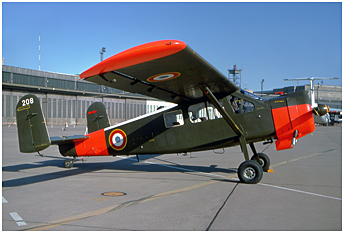
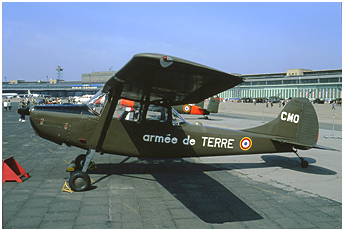 The missions over the BCZ were flown from that airport employing two aircraft types: the Cessna L-19E from Army Light Aviation (ALAT), and then as
reinforcement, the MH 1521M Broussard from the Air Force (a DHC-6-300 Twin Otter replaced the latter in 1988). The Cessna L-19, named "Bird Dog" by the
Americans, began its long career with the French Army in Indochina in 1954 (L-19A) and also served during the war in Algeria as a reconnaissance and forward air
control aircraft during attacks against Fellaghas. It was a small aircraft that was reliable and easy to fly. It reached a cruising speed of 170 km/h with
a 213 HP Continental engine. However, it was not really suited for the observer's work. The latter had to squirm to take pictures because of the narrow cabin.
The L-19 pilot was from the ALAT, on detachment from Baden-Baden. Sometimes the pilot could also be an FMLM pilot officer or a staff member of the FFSB
(French Forces Stationed in Berlin).
The missions over the BCZ were flown from that airport employing two aircraft types: the Cessna L-19E from Army Light Aviation (ALAT), and then as
reinforcement, the MH 1521M Broussard from the Air Force (a DHC-6-300 Twin Otter replaced the latter in 1988). The Cessna L-19, named "Bird Dog" by the
Americans, began its long career with the French Army in Indochina in 1954 (L-19A) and also served during the war in Algeria as a reconnaissance and forward air
control aircraft during attacks against Fellaghas. It was a small aircraft that was reliable and easy to fly. It reached a cruising speed of 170 km/h with
a 213 HP Continental engine. However, it was not really suited for the observer's work. The latter had to squirm to take pictures because of the narrow cabin.
The L-19 pilot was from the ALAT, on detachment from Baden-Baden. Sometimes the pilot could also be an FMLM pilot officer or a staff member of the FFSB
(French Forces Stationed in Berlin).
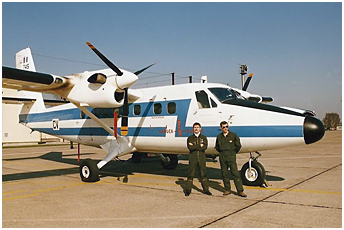
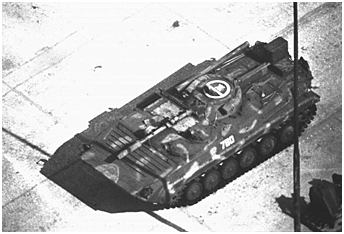 The Broussard operated by the Armée de l'air was piloted essentially by pilot officers of the FMLM. Its role was also to maintain the pilot qualification of
the latter. Thanks to its 450 HP Pratt & Whitney Wasp Junior radial engine, the plane could carry five to six people in addition to the pilot at 220 km/h.
Compared to the L-19, the cabin was larger and the observer, an FMLM NCO or officer, could move from one side to the other to take pictures.
The "Air Recce" missions that lasted between 1H30 and 2H on average consisted of maintaining a unit's order of battle, identify warning signs
(5) in the train stations or on the roads, identify and photograph the equipment and note the arrival of
new equipment. These missions were shared alternatively with the Americans and the British in order to coincide with the programmed rotation of crews of each of
the three Missions that in turn manned the "Local." Thus, during a morning flight, an observer from the army could recognize the targets that he would cover on
the ground in late afternoon. It was intense work, particularly exciting and sometimes risky; the contribution of these Missions to the knowledge of Soviet and
East German forces was significant and irreplaceable. Almost all of the knowledge and monitoring of the Warsaw Pact forces on the territory of the GDR was derived
from the work of the Missions on the ground and in the air.
The Broussard operated by the Armée de l'air was piloted essentially by pilot officers of the FMLM. Its role was also to maintain the pilot qualification of
the latter. Thanks to its 450 HP Pratt & Whitney Wasp Junior radial engine, the plane could carry five to six people in addition to the pilot at 220 km/h.
Compared to the L-19, the cabin was larger and the observer, an FMLM NCO or officer, could move from one side to the other to take pictures.
The "Air Recce" missions that lasted between 1H30 and 2H on average consisted of maintaining a unit's order of battle, identify warning signs
(5) in the train stations or on the roads, identify and photograph the equipment and note the arrival of
new equipment. These missions were shared alternatively with the Americans and the British in order to coincide with the programmed rotation of crews of each of
the three Missions that in turn manned the "Local." Thus, during a morning flight, an observer from the army could recognize the targets that he would cover on
the ground in late afternoon. It was intense work, particularly exciting and sometimes risky; the contribution of these Missions to the knowledge of Soviet and
East German forces was significant and irreplaceable. Almost all of the knowledge and monitoring of the Warsaw Pact forces on the territory of the GDR was derived
from the work of the Missions on the ground and in the air.
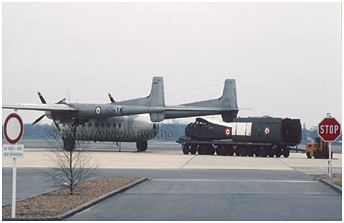
 Aerial observers belonged either to the air force section or to the army section. They spent one, sometimes two, periods of four years at the Mission and were
trained on location at the beginning of their tour of duty. They acquired exceptional skills in equipment identification and photography techniques. One must imagine
the mastery that was required for shooting with a 400mm lens attached to a Nikon motorized body while being tossed about at 150 meters altitude aboard an
unstable aircraft. The picture quality equated to that obtained today by the means implemented by special forces, although personnel did not receive proper
recognition for their work. Monitoring of the BCZ was sometimes supplemented by additional flights designated "technical" in the central corridor connecting West
Berlin to West Germany, when an aircraft flew back to France for maintenance. This type of flight performed without radio contact or IFF was done with the permission
of the Soviet air controllers who required that the aircraft land at Braunschweig in order to verify that it actually had exited the corridor (it was not allowed to
turn back in the corridors). After landing, the pilot was required to call the French controller at the Berlin Air Safety Center (BASC) who in turn informed his Soviet
counterpart working next to him. These flights were made in favorable weather, because maximum visibility was required. It was indeed possible during these missions
to cover targets difficult to observe from the ground or difficult to access because they were located inside permanently restricted areas (PRAs). Examples are the
vast Letzlinger-Heide Training Area, Mahlwinkel Soviet Airfield, SAM sites, theater or strategic radio relays, etc. But most of these areas mainly were monitored by
Gabriel SIGINT aerial platforms (see > Gabriel over Germany). One must understand that intelligence is a synthesis of different
complementary means. The work of the
Allied Military Liaison Missions in the GDR that was often ignored, but appreciated by those who had to use and understand it, has contributed to maintaining the
geopolitical balance of yesterday's Europe under the threat of a conflict between the East and the West back then and now in deep economic crisis.
Aerial observers belonged either to the air force section or to the army section. They spent one, sometimes two, periods of four years at the Mission and were
trained on location at the beginning of their tour of duty. They acquired exceptional skills in equipment identification and photography techniques. One must imagine
the mastery that was required for shooting with a 400mm lens attached to a Nikon motorized body while being tossed about at 150 meters altitude aboard an
unstable aircraft. The picture quality equated to that obtained today by the means implemented by special forces, although personnel did not receive proper
recognition for their work. Monitoring of the BCZ was sometimes supplemented by additional flights designated "technical" in the central corridor connecting West
Berlin to West Germany, when an aircraft flew back to France for maintenance. This type of flight performed without radio contact or IFF was done with the permission
of the Soviet air controllers who required that the aircraft land at Braunschweig in order to verify that it actually had exited the corridor (it was not allowed to
turn back in the corridors). After landing, the pilot was required to call the French controller at the Berlin Air Safety Center (BASC) who in turn informed his Soviet
counterpart working next to him. These flights were made in favorable weather, because maximum visibility was required. It was indeed possible during these missions
to cover targets difficult to observe from the ground or difficult to access because they were located inside permanently restricted areas (PRAs). Examples are the
vast Letzlinger-Heide Training Area, Mahlwinkel Soviet Airfield, SAM sites, theater or strategic radio relays, etc. But most of these areas mainly were monitored by
Gabriel SIGINT aerial platforms (see > Gabriel over Germany). One must understand that intelligence is a synthesis of different
complementary means. The work of the
Allied Military Liaison Missions in the GDR that was often ignored, but appreciated by those who had to use and understand it, has contributed to maintaining the
geopolitical balance of yesterday's Europe under the threat of a conflict between the East and the West back then and now in deep economic crisis.
© Roland Pietrini
Roland Pietrini is the author of "Vostok - Mission de Renseignement au coeur de la guerre froide". See > Multimedia
notes
(1) The abbreviation MT-LB translates literally "multipurpose lightly armored tractor" from Russian.
This amphibious vehicle could carry a dozen soldiers.
The SA-13 "Gopher" (9K35 "Strela-10M" complex) was mounted on an MT-LB chassis.
(2)
The 'local' missions on the ground that Army personnel performed consisted of monitoring H24 the area surrounding the Berlin Wall and all the access
routes leading to Berlin in order to detect warning signs and, based on events or unusual activities that had been observed,
then possibly provide
lucrative tasking for subsequent ground tours.
(3)
The heavy flatbeds were multi-axle platforms used to transport armored vehicles.
M wagons were ordinary freight wagons used to carry escort personnel.
(4)
Operation "Schooner," then "Nylon" and finally "Oberon" for BRIXMIS
Operation "Larkspur" for the USMLM
(5) Any activities likely to announce the preparation of an attack (imminence of hostilities)
were considered warning signs. Thus, on the eve of the
invasion of Czechoslovakia in 1968, a period of radio silence had preceded a period of intense jamming.
 |
The "Air Recce" of the FMLM > Part 2 |
 |
Plan du site - Sitemap |  |

